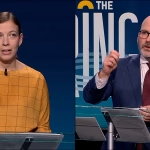The Federal Reserve Bank of Chicago President, Austan Goolsbee, recently expressed his views on the labor market and inflation data, indicating that they support the Fed’s decision to ease interest-rate policy in the near future. Goolsbee highlighted the significant decrease in inflation and the rapid rise in the unemployment rate, suggesting that rate cuts are necessary. He also mentioned warning signs of a cooling labor market, emphasizing the importance of not basing decisions on a single data point. Goolsbee’s concern is that persistent weakness in the labor market could have negative implications and lead to a further downturn.
Following Goolsbee’s statements, the US Dollar Index (DXY) experienced a slight decline, currently trading 0.02% lower at 101.04. This reaction indicates that the market is taking note of the potential changes in interest-rate policy and its impact on the US Dollar. Investors are closely monitoring the Federal Reserve’s decisions and statements to gauge the direction of the economy and the currency.
The Federal Reserve plays a crucial role in shaping monetary policy in the US, with the primary objectives of achieving price stability and fostering full employment. The Fed adjusts interest rates to control inflation and influence borrowing costs in the economy. When inflation rises above the 2% target or the Unemployment Rate is too high, the Fed may raise interest rates to curb inflation. Conversely, when inflation falls below 2% or unemployment is high, interest rates may be lowered to stimulate borrowing and economic growth.
The Federal Open Market Committee (FOMC) holds eight policy meetings a year to assess economic conditions and make monetary policy decisions. The FOMC consists of twelve Fed officials, including the Board of Governors and regional Reserve Bank presidents. These officials analyze data and trends to determine the appropriate policy measures to achieve the Fed’s mandates. In extreme situations, such as during a financial crisis or when inflation is extremely low, the Fed may resort to Quantitative Easing (QE) to increase credit flow in the financial system.
Quantitative Easing (QE) is a non-standard policy measure used by the Federal Reserve to stimulate the economy by purchasing high-grade bonds from financial institutions, effectively increasing the money supply. This process usually leads to a weakening of the US Dollar as more currency is printed and injected into the financial system. Conversely, Quantitative Tightening (QT) is the reverse process of QE, where the Fed stops buying bonds and allows maturing bonds to expire without reinvesting the principal. QT generally has a positive effect on the value of the US Dollar, as it reduces the supply of money in the financial system. Overall, the Federal Reserve’s decisions on interest rates and policy measures have a significant impact on the US economy and the value of the US Dollar in the global market.










